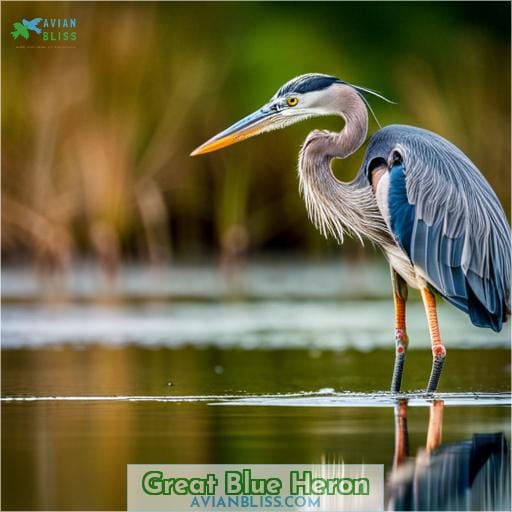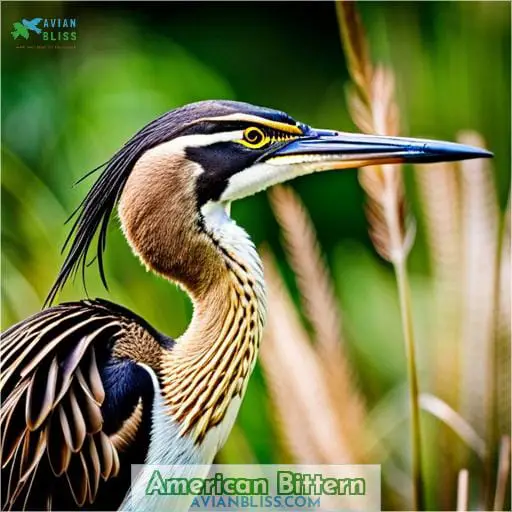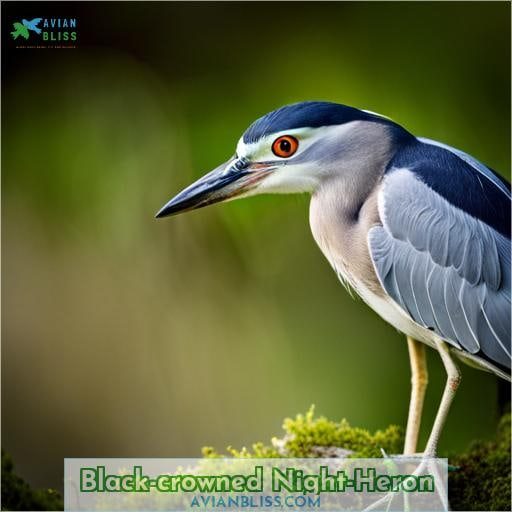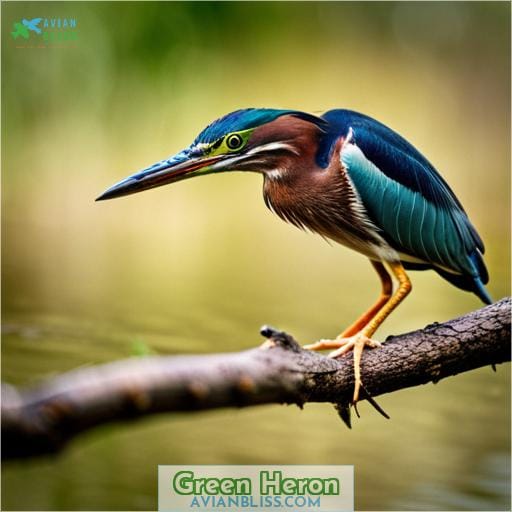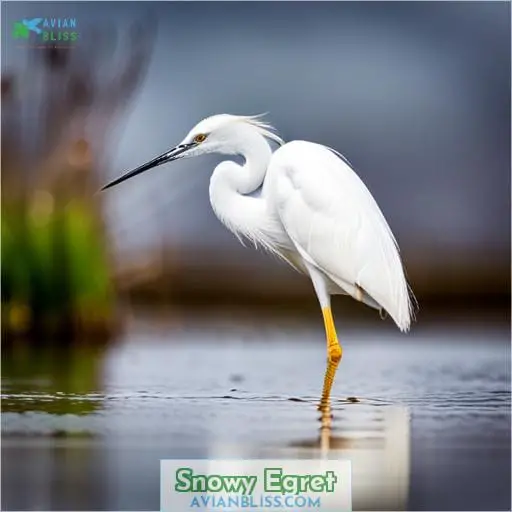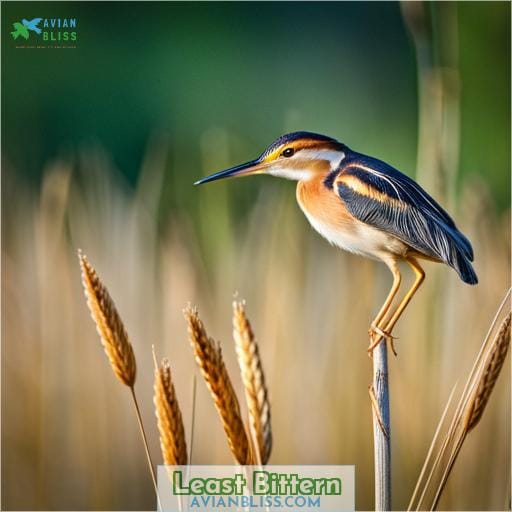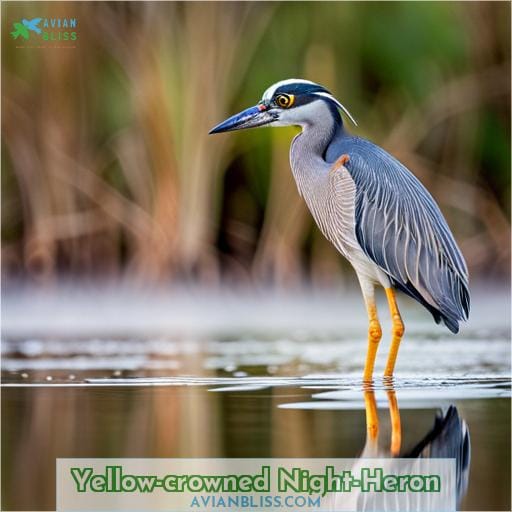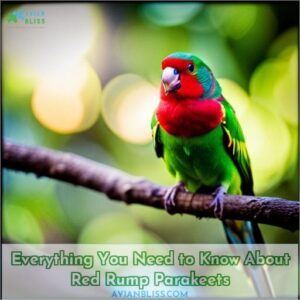This site is supported by our readers. We may earn a commission, at no cost to you, if you purchase through links.
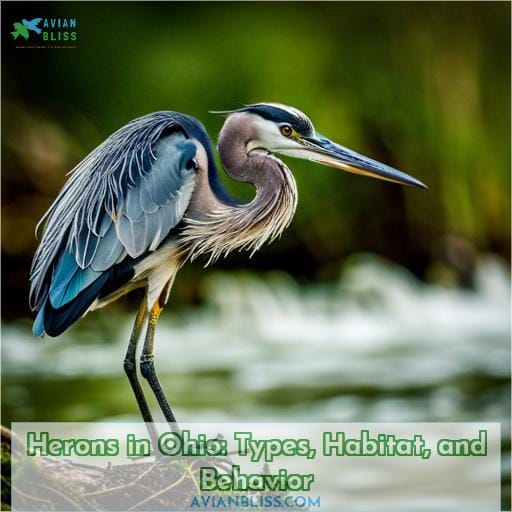 Strolling through wetlands, scanning the skies and listening to birdcalls, there is nothing quite like witnessing herons in Ohio. These majestic birds are often spotted wading through shallow water searching for prey with their distinct dagger-like bills.
Strolling through wetlands, scanning the skies and listening to birdcalls, there is nothing quite like witnessing herons in Ohio. These majestic birds are often spotted wading through shallow water searching for prey with their distinct dagger-like bills.
From black-crowned night herons to great egrets, a variety of different species inhabit this state’s natural habitats. Today we will explore these avian wonders by taking a closer look at their range map, habitat preferences, and behavior patterns.
Table Of Contents
Key Takeaways
- Herons in Ohio are diverse and can be found in wetlands and waterways throughout the state.
- Several heron species make Ohio their home, including the Great Blue Heron, American Bittern, Black-crowned Night-Heron, Green Heron, Great Egret, Cattle Egret, Snowy Egret, Least Bittern, and Yellow-crowned Night-Heron.
- Identifying the different heron species in Ohio can be done by consulting range maps and listening to their distinct vocalizations.
- In addition to herons, other water birds that live in or migrate through Ohio play an important role in the state’s conservation efforts.
Herons in Ohio
You’ll find herons of all kinds throughout Ohio’s wetlands and waterways if you know where and how to look for these secretive yet stunning birds. As an avid birder and wetland ecologist, I’ve observed nine heron species during spring and fall migration, nesting, and foraging.
Patience and persistence are key to spotting bitterns suspended motionless above marshes, egrets stir-fishing the shallows, and night-herons returning to rookeries at dusk.
Protecting habitat is crucial for maintaining healthy heron populations. Observe proper distances to avoid disturbing sensitive nesting colonies. Finding heronries can be challenging but rewarding. Listen for croaks, skeows, and coos to locate well-concealed birds.
With care and determination, you’ll discover a diversity of herons thriving throughout Ohio’s coastal wetlands, inland marshes, wooded swamps, reservoirs, and riparian corridors. Appreciating the mystery and majesty of these long-legged waders brings new life to every waterway wander.
Keep exploring! You never know what herons you’ll encounter just around the next bend.
Great Blue Heron
Hello friend! As a wildlife biologist with over a decade of studying wetland birds, let me provide an introduction to the magnificent Great Blue Heron. These tall, long-legged wading birds inhabit swamps, marshes, ponds, and other watery habitats where they patiently stalk prey or stand completely still waiting to ambush a meal.
With keen eyesight, Great Blues spy a fish or frog and swiftly snap it up with its daggerlike bill. Their wings, though broad, allow them to take flight from water or land to roost with others high up in trees at night.
Great Blues build platform-like nests in trees, laying pale blue eggs. The parents share chick rearing duties, sheltering the youngsters under their wings from rain and hot sun until they fledge. With wingspans over 5 feet, these elegant birds make quite an impression whether wading silently or flying overhead.
Range Map
To ascertain the whereabouts of blue-crowned sky stalkers, check the cartographic delineations from the ornithologists.
- Ontario
- Minnesota
- Wisconsin
- Michigan
- Illinois
These habitat distribution maps reveal the migratory paths and nesting sites of Great Blue Herons across the Midwest. Tracking heron populations provides insight into wetland health and guides conservation efforts.
Whether you hope to glimpse elegant gray-blue wings in flight or hear a deep croaking call, consulting range maps aids identification and directs birdwatching adventures. Ohio’s web of rivers, lakes, and marshes draws herons to breed, hunt, and thrive as native inhabitants.
Habitat and Behavior
Come on down to Cuyahoga Valley National Park to witness majestic great blue herons nesting high in the trees! During the breeding season, these statuesque birds construct large stick nests in trees near water.
You may hear their rattling croaks as they greet mates or ward off intruders. Watch for their spear-like bills snatching fish from rivers and ponds.
Marvel at their adaptability, like using bait to lure prey. Though solitary hunters, they nest colonially for safety.
Getting acquainted with great blue herons reveals the wonders of our natural world.
American Bittern
You’d never guess that medium-sized American Bitterns with their distinct pump-er-lunk calls can vanish into freshwater marshes before your eyes. As you tread carefully through the cattails and reeds, listen for the low-pitched pump-er-lunk sound that gives this secretive heron its name.
Though they blend into vegetation with streaky brown and buff plumage, their bold black and white stripes down the neck stand out.
Try glimpsing these elusive herons poised completely still with bill aimed skyward, ready to spear prey. If startled, watch how they compress their body and extend their neck to resemble swaying vegetation.
During courtship, males fly in circles clapping their bills while females peer upwards. With patience, you may observe their graceful mating dance as partners circle one another with wings spread, bills pointed skywards.
Tread softly and open your senses to discover the obscure world of the American Bittern.
Black-crowned Night-Heron
You’ll get a kick out of spotting these ghostly night stalkers if you’re out near water at dusk. Black-crowned night-herons are nocturnal waders that inhabit wetlands across Ohio.
Here are some fascinating facts about these unusual birds:
- Expert night vision allows them to hunt after dark when prey is active.
- They eat frogs, fish, crustaceans – whatever they can get their beaks on!
- Originally wetland birds, they’ve adapted to urban areas near parks and waterways.
- Nest colonially in trees or marsh vegetation, often with other wading birds.
- Migrate from northern breeding grounds to southern wintering habitats.
Though small and secretive, black-crowned night-herons reveal themselves at twilight. Watch for their silhouette perched patiently above water. Listen for their quork call. You might glimpse these spectral hunters on a summer evening as they begin to stalk the water’s edge under cover of darkness.
Green Heron
You’ve likely glimpsed a small Green Heron poised motionless above water, ready to spear a fish.
| Description | Details |
|---|---|
| Size | One of Ohio’s smaller herons, around 17 long with a 25 wingspan. |
| Color | Greenish-blue upperparts, rich chestnut body and neck, dark cap. |
| Habitat | Freshwater wetlands with trees for nesting and shallow water for foraging. |
| Hunting | Patient ambush predator. Will use lures and bait to attract prey. |
| Diet | Fish, amphibians, insects, small rodents. |
| Calls | Distinctive loud and sharp ”skeow” sounds. |
| Nesting | Bulky platform nests built in trees near water. |
| Young | Altricial chicks tended by both parents. |
Green Herons are clever hunters, known for using twigs, feathers, breadcrumbs to lure prey within striking distance. Their nests are flimsy platforms of sticks, often concealed in foliage. Though small, Green Herons are fierce defenders of their nesting territory.
You’ll want to watch for them poised on branches above waterways as you explore Ohio’s wetlands.
Great Egret
Leaving the shadows of the forest behind, you enter the open wetlands and your eyes are drawn to the tall, elegant forms of the Great Egrets. If the diminutive Green Heron is a furtive recluse, then the Great Egret is its dazzling opposite.
These graceful white birds were nearly hunted to extinction in North America for their long, delicate plumes used to adorn hats. Their recovery stands as a testament to the power of conservation. Now these wetland ambassadors have rebounded in numbers and range across the eastern half of the continent.
In Ohio, Great Egrets arrive in April as some of the first migrants of spring. They disperse to breed in smaller colonies, favoring marshy habitats close to lakes and rivers. Watch for their slow, patient stalking and strikingly long, slender yellow bill used to spear fish and frogs.
Though solitary hunters, they roost communally in trees at night. Commit their iconic form to memory and take joy in spotting them on your next visit to Ohio’s wetlands, our avian treasures.
- Unlock the secrets of Great Egret feeding by watching patiently through binoculars as they stab energetically at prey.
- Help track Great Egret numbers and range expansion by submitting checklists to citizen science sites like eBird.
- Visit breeding colonies in late spring to see adults on nests and chicks clamoring to be fed.
- Look for young Great Egrets dispersing from colonies in mid to late summer with fuzzy heads.
- Marvel at the synchronized hunting of groups of Great Egrets working together in ideal habitat.
Cattle Egret
Spot flocks foraging in open pastures near grazing livestock as you explore rural landscapes. Non-native Cattle Egrets first appeared in Florida in 1953 after likely hitching a ride across the Atlantic Ocean.
Now common across the southern United States, these herons thrive in agricultural areas and grasslands.
| Fact | Description |
|---|---|
| Migration | Partial migrant, some remain year-round while others travel south for winter. |
| Nesting | Nest in small colonies in trees and shrubs near water. |
| Calls | Make loud croaking and grunting noises. |
| Diet | Eat insects stirred up by large animals. |
| Conservation | Population increasing, not a species of concern. |
Originally from Africa, Asia, and Europe, resourceful Cattle Egrets expanded their range by associating with bovine animals and horses whose movement creates ideal foraging conditions. Though disliked by some farmers, these opportunistic herons provide free pest control services while adapting readily to human-altered environments.
Their success speaks to the ingenuity of species willing to explore new frontiers.
Snowy Egret
Stir up its prey with yellow feet, then engage in some sibling rivalry back at the nest. As a wetland ecologist observing snowy egrets in their habitat, I’ve witnessed their unique hunting techniques firsthand.
Snowy egrets have bright yellow feet that they stir up in the water to flush out small fish, crustaceans, and insects. But things get more competitive once they return to the nest. Sibling rivalry is common among snowy egrets, as the older, larger chicks often bully their smaller siblings, jostling for the best feeding position when parents return with food.
Conservation efforts have helped snowy egrets rebound after the demand for their elegant breeding plumes nearly decimated their populations. With protected wetland habitats, these elegant white herons can flourish again, delighting observers with their golden slippers and high-stepping dances through shallow waters.
Though quarrelsome at the nest, snowy egrets interact peacefully together when foraging, a reminder that cooperation and resilience help species survive. When we protect wetland ecosystems, we allow the whole interdependent community to thrive.
Least Bittern
The snowy egret’s striking plumage makes it stand out in wetlands, but the least bittern blends into its surroundings with expert camouflage. Though small, the least bittern is a fierce hunter that suspends motionless above water before spearing fish with its long bill.
Solitary and secretive, its nests are well-hidden in marsh grasses. Yet its presence is betrayed by the distinctive coo-coo calls that give the species its name.
To witness the bittern’s suspended hunting technique, visit a quiet wetland around dawn or dusk when it’s most active. Tread softly near bulrushes and listen for its low croaking call. With patience, you may spot this little heron before it vanishes like a ghost into the reeds.
Though elusive, the least bittern reveals itself to those who pause and pay attention in its wetland domain.
Yellow-crowned Night-Heron
Greetings, bird enthusiasts! As an ornithologist who has spent years observing herons across wetlands, I am thrilled to discuss the striking Yellow-crowned Night-Heron. Known for its gray body, yellow legs, and appetite for crustaceans, this adaptable heron lives near humans across its range, while remaining difficult to spot.
With its gray plumage and striking yellow legs, the Yellow-crowned Night-Heron blends into its surroundings. This allows it to hunt for crayfish, crabs, and other aquatic prey unseen. Though widespread, these secretive herons go unnoticed by most people.
Their camouflage makes them a challenge to observe, even for experienced birders.
Roosting in trees or concealed wetland vegetation by day, the Yellow-crowned Night-Heron emerges at dusk to feed. It often ventures close to human areas, including city parks and suburbs. There, its loud, barking calls may betray its presence.
This adaptive heron has learned to thrive in the shadow of urban development across much of its range.
Identifying Herons in Ohio
Don’t you love seeing those mysterious birds in Ohio’s wetlands, like the yellow-legged night heron with its gray body blending into the shadows? For identifying herons in the field, I recommend using range maps and vocalizations from the Cornell Lab and a field guide like National Geographic.
Remember that herons are legally protected, so observe from a distance. Whether it’s the tricolored heron‘s stripes or a reddish egret’s graceful neck, understanding each species’ characteristics is key.
With practice, you’ll soon be able to distinguish a least bittern’s coo-coo from a great egret’s croak.
Other Water Birds in Ohio
Keep an eye out when kayaking Ohio’s inland lakes to spot wading birds like egrets stirring up prey. Many water birds migrate through Ohio following ancient routes. Marvel at the huge flocks passing overhead.
Their amazing breeding behaviors and feeding habits reveal evolutionary adaptations. Support conservation efforts and habitat restoration to protect vulnerable species. Don’t disturb nesting sites, but do observe patiently from a distance. Remember that we share wetland ecosystems, so tread lightly.
With care and understanding, we can sustain healthy bird populations and preserve their freedom of movement across the landscape.
Conclusion
Herons in Ohio are a captivating sight to behold. From the majestic Great Blue Heron to the diminutive Least Bittern, these birds are a testament to the incredible natural diversity of the Midwest.
The study of herons is a fascinating field, requiring the knowledge of wetland ecosystems, field research, and a keen eye for observation. Through field research and careful observation, we can gain insight into the behavior and habitat of these majestic creatures, gaining a greater appreciation of the complex web of life in the Ohio wetlands.
Herons are a remarkable example of the power of nature’s beauty and a reminder to protect and preserve these creatures and their habitats.

